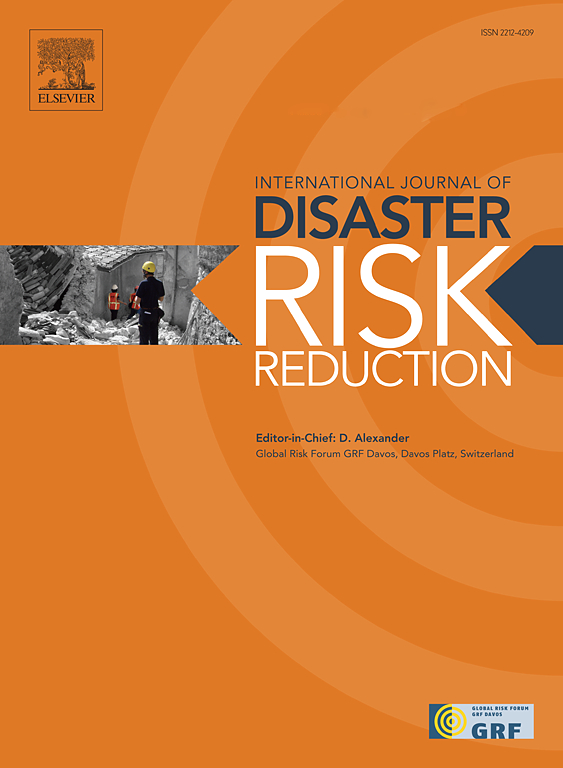Population activity recovery: Milestones unfolding, temporal interdependencies, and relationship with physical and social vulnerability
IF 4.2
1区 地球科学
Q1 GEOSCIENCES, MULTIDISCIPLINARY
International journal of disaster risk reduction
Pub Date : 2024-11-01
DOI:10.1016/j.ijdrr.2024.104931
引用次数: 0
Abstract
Understanding sequential community recovery milestones is crucial for proactive recovery planning and monitoring and targeted interventions. This study investigates these milestones related to population activities to examine their temporal interdependencies and evaluate the relationship between recovery milestones and physical (residential property damage) and socioeconomic vulnerability (through household income). This study leverages post-2017 Hurricane Harvey mobility data from Harris County to specify and analyze temporal recovery milestones and their interdependencies. The analysis examined four key milestones: return to evacuated areas, recovery of essential and non-essential services, and the rate of home-switch (moving out of residences). Robust linear regression validates interdependencies between across milestone lags and sequences: achieving earlier milestones accelerates subsequent recovery milestones. The study thus identifies six primary recovery milestone sequences. We found that socioeconomic vulnerability accounted through the median household income level, rather than physical vulnerability to flooding accounted through the property damage extent, correlates with recovery delays between milestones. We studied variations in recovery sequences across lower and upper quantiles of property damage extent and median household income: lower property damage extent and lower household income show greater representation in the “slowest to recover” sequence, while households with greater damage and higher income are predominant in the group with the “fastest recovery sequences”. Milestone sequence variability aligns closely with income, independent of physical vulnerability. This empowers emergency managers to effectively monitor and manage recovery efforts, enabling timely interventions.
人口活动的恢复:正在展开的里程碑、时间上的相互依赖以及与身体和社会脆弱性的关系
了解连续的社区恢复里程碑对于积极的恢复规划、监测和有针对性的干预措施至关重要。本研究调查了这些与人口活动相关的里程碑,以研究其时间上的相互依赖性,并评估恢复里程碑与物理(住宅财产损失)和社会经济脆弱性(通过家庭收入)之间的关系。本研究利用哈里斯县 2017 年 "哈维 "飓风后的流动性数据,明确并分析了时间上的恢复里程碑及其相互依存关系。分析考察了四个关键的里程碑:返回疏散地区、基本和非基本服务的恢复以及家庭转换率(搬离住所)。稳健的线性回归验证了各里程碑滞后期和序列之间的相互依存关系:实现早期里程碑可加快后续恢复里程碑的实现。因此,本研究确定了六个主要的恢复里程碑序列。我们发现,通过家庭收入中位数计算的社会经济脆弱性,而不是通过财产损失程度计算的洪灾物理脆弱性,与里程碑之间的恢复延迟相关。我们研究了财产损失程度和家庭收入中位数的上下限恢复顺序的变化:财产损失程度较低和家庭收入较低的家庭在 "恢复最慢 "的顺序中占有较大比例,而财产损失程度较高和收入较高的家庭在 "恢复最快 "的顺序中占有较大比例。里程碑序列的变化与收入密切相关,与身体脆弱性无关。这使应急管理人员能够有效地监测和管理恢复工作,及时采取干预措施。
本文章由计算机程序翻译,如有差异,请以英文原文为准。
求助全文
约1分钟内获得全文
求助全文
来源期刊

International journal of disaster risk reduction
GEOSCIENCES, MULTIDISCIPLINARYMETEOROLOGY-METEOROLOGY & ATMOSPHERIC SCIENCES
CiteScore
8.70
自引率
18.00%
发文量
688
审稿时长
79 days
期刊介绍:
The International Journal of Disaster Risk Reduction (IJDRR) is the journal for researchers, policymakers and practitioners across diverse disciplines: earth sciences and their implications; environmental sciences; engineering; urban studies; geography; and the social sciences. IJDRR publishes fundamental and applied research, critical reviews, policy papers and case studies with a particular focus on multi-disciplinary research that aims to reduce the impact of natural, technological, social and intentional disasters. IJDRR stimulates exchange of ideas and knowledge transfer on disaster research, mitigation, adaptation, prevention and risk reduction at all geographical scales: local, national and international.
Key topics:-
-multifaceted disaster and cascading disasters
-the development of disaster risk reduction strategies and techniques
-discussion and development of effective warning and educational systems for risk management at all levels
-disasters associated with climate change
-vulnerability analysis and vulnerability trends
-emerging risks
-resilience against disasters.
The journal particularly encourages papers that approach risk from a multi-disciplinary perspective.
 求助内容:
求助内容: 应助结果提醒方式:
应助结果提醒方式:


